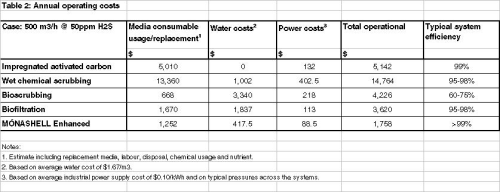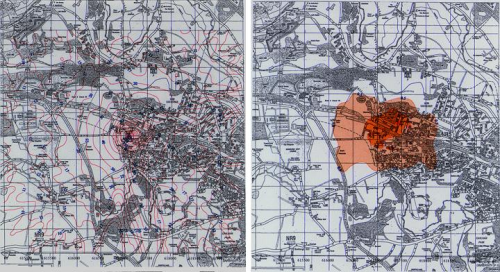



In response to a rapidly changing world, with ever increasing pressures on our environment, we continue to develop and implement more stringent environmental legislation. Arising from this and an understanding of the impact of pollutants, there is an increasing requirement for economic and environmentally sustainable treatment options for various types of emissions to the environment.
Malodour is the most “visible” indicator of environmental pollution and as such is regarded as unacceptable. In its simplest form, odour is caused by the interaction between specific airborne chemical species and the human olfactory system. Chemical compounds which are regarded as malodorous are generally detected by the human olfactory system at very low concentrations (parts per billion) and are associated with rotting or decaying matter of animal or vegetable origin. Because of this, low concentration malodours do not cause physical harm but affect human wellbeing and quality of life. This impact can be eliminated by the application of odour abatement technology.
Analytical methods exist for measuring odour intensity, tone and strength. The unit of measurement is calculated using dilution to threshold calculation (level at which odour is just detected) and can be expressed relative to volumetric measurements or units of time. The impact can be represented on a map using contour lines for odour strength (known as isopleths) at specific locations (see Figures 1 and 2). Odour mapping can be used to demonstrate the impact of odour abatement technology on, in, and around an odour generating site and the impact at nearest sensitive receptors. Generally, the objective is to reduce odour level at site boundaries to below levels which will cause offence (95% of the time as a minimum).
Bord na Móna Environmental has over twenty years experience in developing and implementing environmental solutions for the treatment of air and water emissions. Their shell based technology MÓNASHELL represents a break through in the treatment of odours and VOC (Volatile Organic Compounds) emissions. The technology, originally developed in Europe, has been employed in over five hundred installations worldwide. This low cost technology broadened the field of applications for biotechnologies due to its capacity to treat high concentrations of difficult compounds. This is a way for biotechnologies to compete against chemical scrubbers and thermal systems with a low cost sustainable robust alternative that uses minimum energy and has zero chemical inputs. This patented technology has the lowest environmental impact, operating costs and lowest total cost of ownership.
Biological treatment technologies
A number of key parameters need to be identified and characterised prior to discussing in detail the development and relative merits of biological and enhanced biological treatment technologies. A clear understanding of the relationship between containment structures, ventilation rates, appropriate equipment selection, meeting the necessary efficiencies and, perhaps most importantly, the capital and operational costs is required. In order to develop successful control strategies, an understanding of odour measurement and chemical characterisation of the chemical constituents specifically responsible for odour (the perception of odour is a reaction to specific chemical compounds) is required. An understanding of dispersion modelling to assess the impact to boundary and the nearest sensitive receptor is also useful. These variables are essential for establishing inlet conditions and performance parameters prior to selection of an odour abatement process.
One point which warrants reinforcement is that the removal of the dominant odorous component from the air stream does not guarantee significant odour removal. Other compounds which were previously being masked will now contribute to an overall odour. The requirement for an effective odour removal plant is good removal performance for the full range of compounds, which have low odour threshold values (i.e. those whose odour may be detected at very low concentrations).
Wastewater applications
In the main, when dealing with municipal wastewater treatment plants, most odours arise where anaerobic conditions (no oxygen) are prevalent, allowing sulphur reducing bacteria to flourish. The result is the formation of dissolved sulphides/hydrogen sulphide in the wastewater which will be released to atmosphere where conditions are favourable (typically high liquid/air interface and liquid turbulence). The problem is exacerbated during periods of warm weather, as biological activity increases with temperature (leading to an increased rate of production of odorous compounds).
Reducing septically will significantly reduce odours and it is a valid strategy for effective odour control. However, it will not necessarily provide the degree of performance and reliability required. Where the potential for significant odour emissions exists, such factors as containment, ventilation and treatment need also to be considered. Before discussing biological treatment options in detail it is critical to understand the relationship between (minimising volume and air tight) containment, which will lead to a reduction in the ventilation requirement (leading to reduced air flow duct work and efficient fan power requirements and size of odour control equipment) and the converse effect on concentration (i.e. increased concentration) of contaminants and hence the challenge to the odour control equipment.
Traditionally, the most prevalent abatement technologies employed for odour control on wastewater are shown in Table 1. All of the technologies listed in Table 1 possess strengths and weaknesses in relation to applications on wastewater treatment. Of note, is that very often, the technologies are combined to manage full treatment.
Biofiltration
Originally developed from soil filters where odorous air was passed through a bed of soil, the contaminants are removed and oxidised naturally in the soil by the action of specific bacteria. Early systems suffered problems due to drying out of the soil and the unhomogeneous nature of the material itself leading to channelling uneven distribution and poor treatment.
Significant improvements to the process were achieved through better selection of organic media and products such as peat fibre/heather mixes and granulated products. The patented Mónafil product overcame these problems by offering a more homogenous engineered media with high specific surface area, high void volume, good water retention properties and drainage characteristics, and good adsorption properties.
The benefits with the Biofiltration technology are:
- Excellent removal efficiency of broad range of compounds in a single stage;
- More modern filters employing high quality media have low pressure characteristics and hence low running costs;
- No chemical consumables hence very low running costs. Final effluent can also be employed to maintain moisture content;
- Operational simplicity requires minimal maintenance and controls;
- No secondary pollution.
The drawbacks with the Biofiltration technology are:
- pH Control – the limiting factor for conventional biofilters treating sulphur compounds. This can be controlled by washing out with irrigation water. However, it is generally held that for containment levels above 50 ppm, pre-treatment should be considered.
- Contaminated concentration is a limiting factor.
- Selection of poor quality filter media leads to pressure and performance problems often giving the technology a poor reputation.
Biotrickling filter
Biotrickling filters are constructed similar to a chemical scrubber employing randomly packed plastic packing. In comparison to a chemical scrubber a much larger contact time is employed and a nutrient solution may be added to the recirculated liquid to encourage development of a biofilm on the plastic packing. The principle benefit of the technology is a reduced footprint when compared to biofiltration phase and an ability to handle higher concentrations by employing organic media.
The drawbacks are:
- Poor removal efficiency (typically 70%) which means this technology can rarely be employed as a stand alone technology;
- Reliance on residual water hardness for removal of sulphur compounds;
- Biofouling – if the supply water or the air stream has a significant organic component the system is prone to blocking with biomass;
- Treatment of low solubility VOC’s and organic sulphate compounds is limited.
The patented MÓNASHELL technology is a process which utilises a naturally occurring shell media. The media employed has an adsorption a chemical affinity for sulphur compounds (chemisorption). The physical shape, size and rigidity render it highly effective as a scrubber packing in its own right (absorption mass transfer). In addition, the pH buffing and slow release nature of the media renders it ideal for pH control.
The physical and chemical properties of the shell media affects the main advantages associated with adsorption systems, wet chemical scrubbers and biological treatment systems without many of the disadvantages. The technology is also extremely effective on the more difficult organic sulphur compounds and has been further developed for treatment of high levels of VOC (Volatile Organic Compounds) on industrial applications.
Multi-staging dynamic
The most recent development in the suite of odour control technologies is the use of multi-staging with a low contact time (similar retention to once through systems). This dynamic has been employed to achieve high removal efficiencies on highly concentrated air streams (>99.9% removal). The multistaging approach was developed in response to the occurrence of very difficult airstreams, where a solution not entailing excessive cost to the end-user was required. Multi-staging is now a standard design criteria when responding to clients with fluctuating and high emissions where polishing is required. In addition, a considerable amount of in-house work has been carried out on the use of various shell species in the MÓNASHELL system with respect to density, void space and calcium content. This has resulted in extended media life guarantees to clients, which reduces life cycle costs considerably.
The significant process advantages of the Enhanced Biological Filters over the conventional biological systems are:
- Ability to treat high and variable contaminant levels;
- In built pH control means no addition of chemicals required;
- Ability to treat VOCs and low solubility compounds;
- Typical efficiency achieved is 98%. Efficiencies in excess of 99.9% can be achieved by multi-staging with low contact times;
- Residual media can be disposed of as nonhazardous landfill;
- Excellent performance on the broad range of odour compounds (nitrogen, sulphur compounds and low solubility VOCs);
- Proven on a broad range of municipal and industrial applications.
The efficiency, flexibility, robustness and low capital and operating costs makes MÓNASHELL the ideal solution for most odour control applications on wastewater treatment plants.
Cost comparisons
It is difficult to carry out a meaningful capital cost comparison without recall to detailed specification. In general terms, it can be stated that the capital costs for chemical scrubbers, bioscrubbers and biofilters are broadly similar with activated carbon having a lower capital cost. The most significant difference in relation to operating cost is where very often the costs for twelve months operation can be more than the actual cost of the plant. Please refer to Table 1 for typical annual operating costs.
Applications
With hundreds of other installations worldwide, projects of note include SIAAP in Paris which is the largest wastewater treatment plant in Europe; Bransand, Northumbrian Water, UK;
Monza Wastewater Treatment Facility in Italy; and a more recent addition is at Northpoint pumping station in Hong Kong. The MÓNAFIL technology is currently treating 1,000,000 m3 per hour of air from four of the five large composting installations in Rome (Malagrotto, Viterbo, Albano, and Ama).
The first MÓNASHELL installation in the US will be at the company’s innovation centre at the Greensboro Municipal Treatment Works, where it will be independently monitored and validated by a local university. The Clean Air Solutions range of technologies will deliver low cost, highly effective solutions yielding significant benefits in terms of environment, cost, energy and chemical consumption and long term sustainability.
Contact:
Ian Phillips
Manager, Air & Water Solutions
Bord na Mona Environmental Limited
Ireland
Email: Ian.phillips@bnm.ie
www.bordnamona.com



